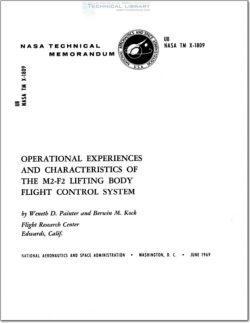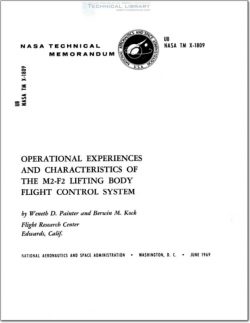NASA-TM-X-1809

- Version
- 174 Downloads
- 1.52 MB File Size
- 1 File Count
- June 15, 2016 Create Date
- June 15, 2016 Last Updated
Operational Experiences and Characteristics of the M2-F2 Lifting Body Flight Control System

Flights of the M2 —F2 lifting body demonstrated that the manual control system and
the stability augmentation system met the operational flight control requirements for the
test vehicle. The regions of pilot-induced oscillation predicted from ground simulation
were encountered in flight. The pilots considered the control system to be adequate for
the M2 -F2 flight envelope flown.
Limit-cycle data obtained during ground tests agreed with flight results. Struc—
tural frequencies of the vehicle control surfaces were never sustained in flight as a
result of filtering in the stability augmentation system.
With the increasing interest in space research, considerable effort is being devoted
to developing a reentry vehicle that will combine some of the design and operational
simplicity of a capsule with the mission flexibility of a piloted maneuverable reentry
vehicle. Experience in landing low -lift—to-drag ratio airplanes indicated that a lifting-
body vehicle could be landed. The hypothesis was proved with a lightweight lifting
body, the M2 -F1 (refs. 1 to 4). The M2—F2, which is a follow—on, heavyweight version
of the M2 -F1, was built under contract to NASA specifications and was delivered in
June 1965 for flight testing at subsonic and low supersonic speeds. The general shape
of the M2 -F1 vehicle was retained, but a more sophisticated control system was de—
signed to enable the pilot to improve the controllability and maneuverability of the ve—
hicle. The design of the flight control system emphasized simplicity and reliability.
Standard aircraft design practices were followed and existing off-the-shelf hardware
was used where practical.
Flight tests with the M2 —F2 were conducted by a joint U. S. Air Force and NASA
Flight Research Center flight —test team at Edwards Air Force Base, Calif. On the
sixteenth flight in May 1967 , the vehicle was extensively damaged on landing.
| File | Action |
|---|---|
| NASA-TM-X-1809 Operational Experiences and Characteristics of the M2-F2 Lifting Body Flight Control System.pdf | Download |

Comment On This Post